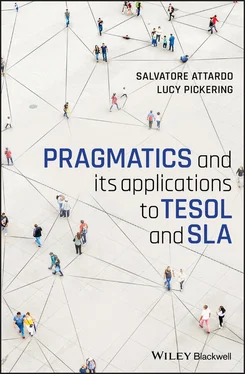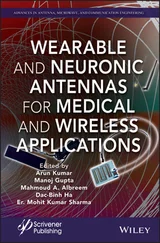1 ...7 8 9 11 12 13 ...19 Sociopragmatic knowledge comprises a speaker’s understanding of what contextual information (Section 1.1.3) needs to be taken into consideration in order to perform a speech act correctly or even at all. For example, in early work as part of the CCSARP Project (Cross-Cultural Study of Speech Act Realization Patterns), Blum-Kulka and Olshtain (1984, p. 209) suggest that coming late to a work meeting may be perceived as a more serious offence in an American setting than in a comparable Israeli one, and thus Americans, as a group, will tend to apologize more intensely than Israelis would expect in this situation. For further discussion of context, see Section 8.3.
A second area of pragmatics that is relevant here is politeness. Traditionally viewed through Brown and Levinson’s (1987) politeness theory, three variables
1 social power,
2 social distance, and
3 degree of imposition
are regarded as “universal constraints on linguistic action” (Kasper & Schmidt, 1996, p. 155). We can also assume that some of the strategies used to address these factors may be universal such as the use of indirect vs. direct language or the use of mitigating language. This area also includes the use of interactional discourse markers, semantic formulas, and routines including conventional expressions, for example, those that are frequently used to convey relational goals, such as nice to meet you . Wildner-Bassett describes these as “the polite noises we make every day in countless situations, the oil we need to keep the social machine running smoothly” (1994, p. 4). While these “polite noises” are universally expected across cultures, their pragmalinguistic realization and even sociopragmatic context can be very different. In another example from her German as a Foreign Language learners, Wildner-Bassett demonstrates that American English speakers carry over a routine from English, I’ll remember that into pragmatically inappropriate German ※ ich erinner mich daran (‘I remind myself of that’), as opposed to the correct form ich werde es mir merken (‘I’ll keep that in mind’; pp. 10–11).
Again, although it is clear that these constraints will apply across speech communities, expectations regarding when and how they are expressed can be very different. For example, politeness in interaction would seem to be a fairly straightforward notion and being more polite rather than less polite would be thus a safer option. However, over-politeness, “behavior which is evaluated as too polite for the context” (Izadi, 2016, p. 13), can be just as damaging as impoliteness, as it can be perceived as “mock politeness” or “insincere politeness.” Izadi gives several examples from Persian that can be disruptive in cross-cultural contexts including ritualized practices such as perceived over-complimenting or offering food or drink to an adjacent person (who may be a total stranger on an airplane) multiple times. We will look at the field of politeness, which has expanded considerably over the past few decades, in more detail in Chapter 5.
2.2 What Do Learners Typically Transfer from Their L1?
To some extent the answer to this is, of course, any linguistic action that is performed in a social context and that the learner may consciously or unconsciously transfer due to their lack of knowledge of the L2. However, research allows us to be more specific in terms of general features of pragmatic development. For example, beginning learners will be limited in terms of both their pragmalinguistic and sociopragmatic strategies. Their grammatical competence is simply not yet strong enough to provide them with the range of linguistic structures that they need to express their intentions. Examples such as Me no want or literal translations from the L1 may be the result of underdeveloped grammatical competence. Sociopragmatic strategies are also more likely to be directly transferred. Istifçi (2009) found that intermediate level learners of English from Turkey included the notion of blame in their English apology structure. For example, by shifting blame onto the hearer (e.g., why didn’t you remind me? ). Although this is a sociocultural norm in Turkish, it is not common in English apology structures. She further found that learners at an advanced proficiency in English no longer transferred this aspect of apology structure. Thus, proficiency is one driver of certain kinds of transfer.
There are other possible root causes for transfer effects. Olshtain (1983) proposes that learners may be more or less likely to transfer L1 sociocultural rules depending on their perception of “language specificity or language universality” (p. 233). In other words, given the same situation in both the L1 and L2, in this case different apology situations, some learners believe that the choice to apologize should be based on their understanding of only the L2 pragmatics (i.e., a language specific approach). However, other learners focus only on the situation and believe that an apology is always/never warranted regardless of the particular language in question (i.e., a universal approach). Olshtain reports her results regarding apologies in Hebrew by Russian and English learners by language group and suggests that overall, English learners of Hebrew approached apologies in a language specific way while Russian learners had a more universal approach.
Another possible cause of transfer from the L1 is resistance to the pragmatic norms or the expression of them in the L2 (Iwasaki, 2011; Trosborg, 2010). Siegal (1994, 1996) explores this issue with female learners of Japanese who lived and worked in Japan. Although these second-language learners “were concerned with being polite and not causing offence,” there was also some resistance to adopting some of the pragmatic norms when they were considered by the learners to be inappropriate. For example, in the words of Karen, a 25-year-old American English professor and Japanese language student, living in Hiroshima, Japan, (1991):
I don’t think I’ve found my Japanese persona yet, who I am when I am speaking Japanese? I was listening to this lady speaking on the telephone in a little squeaky voice (imitates voice) it’s like no I don’t think I can do that, it’s not for me – um – I don’t know.
( Siegal, 1996 , p. 356 )
Dewaele (2008) further develops this idea of appropriateness and suggests that some learners develop a very keen sense of metapragmatic awareness, which they are willing to adapt to while others have a more “ambiguous attitude” toward adopting different language behaviors. As Dewaele notes, the issue of agency in conscious deviation from the target language also complicates the notion of pragmatic failure. The traditional definition of pragmatic failure is “communication breakdown caused by lack of pragmatic competence” (Matsuda, 1999, p. 40; or see Thomas (1983) for a more detailed definition), which seems to assume a lack of knowledge of sociocultural norms. However, this definition does not seem to allow room for full recognition of these kinds of deliberate choices by learners. We will look further at pragmatic failure in Chapter 8.
2.3 Can Pragmatics be Taught through Instruction?
All the research in this area, and there is plenty, shows that the answer to this question is, in general, yes; and, that instruction is preferable to exposure alone (Gharibeh et al., 2016; Rose, 2005). In addition, recent meta-analyses (Plonsky & Zhuang, 2019; Taguchi, 2015) confirm the long-standing findings that instruction may be most effective if it is explicit and includes metapragmatic explanation (Gavamnia et al., 2014) and communicative practice (Gu, 2011). The next obvious questions are what and how, that is, what areas of pragmatics and how best can we teach them? By far the most work has been done with the teaching of speech acts including requests, compliments, refusals, apologies, complaints, and suggestions among others. Explicit instructional techniques have included “awareness-raising” activities such as role-plays, examining natural discourse, or conversation analysis (Gu, 2011; Nyugen et al., 2012; Soler, 2005; Takahashi, 2001). Much of this work is conducted in EFL contexts with limited opportunity to engage in real-life language use with interlocutors other than learners’ peers and teachers, and researchers have frequently used video input teaching techniques. For example, Alcón Soler and Pitarch (2013) used examples from the TV series Stargate to demonstrate refusal strategies in their successful instructional treatment, and Bagherkazemi (2014) found an improvement in learners’ productions of apologies, requests, and refusals following manipulation of materials from the series Lost and Friends and the movie Doubt . Some implicit feedback in the form of recasts has also been shown to be effective in teaching L2 speech acts (Koike & Pearson, 2005; Martínez-Flor & Fukuya, 2005) and also in improving learners’ confidence in their pragmatic skills (Martínez-Flor, 2006). To a much lesser degree, other areas of pragmatics that have been investigated with regard to instruction include the use of hedging devices, discourse and interactional markers, indirect speech acts, and implicature. As we address these different areas of pragmatics in the following chapters, we’ll look more at what kind of instruction has been used and shown to be effective.
Читать дальше












